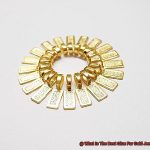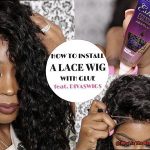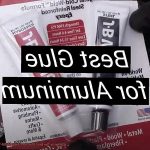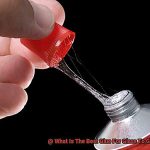Sick of the glue guessing game when it comes to felt and foam crafts?
I’ve got your back. In this blog post, we’re diving headfirst into the sticky world of glues to find the perfect match for your projects.
Felt and foam are delicate darlings that need a glue that won’t ruin their texture or looks. We’ll be breaking down the pros and cons of popular options like fabric glue, hot glue, and spray adhesive.
By the time we’re done, you’ll have a clear winner for your project, guaranteeing your felt and foam creations stand strong against time. Ready to get stuck on this?
Let’s go.
Different Types of Glue Suitable for Felt and Foam
Contents
- 1 Different Types of Glue Suitable for Felt and Foam
- 2 Fabric Glue: An Ideal Choice for Crafting Projects
- 3 Hot Glue: Versatile and Quick-Drying
- 4 Clear Craft Adhesive: Perfect for Intricate Projects
- 5 Waterproof Adhesives: Ideal for Outdoor Applications
- 6 General-Purpose Adhesives: Considerations to Keep in Mind
- 7 Choosing the Right Glue for Your Project
- 8 Tips on Applying Glue to Felt and Foam
- 9 Conclusion
In the world of crafting, finding the right glue for bonding felt and foam materials is like discovering the perfect tool for a job. It can make all the difference in the strength and longevity of your creations. In this comprehensive guide, we will explore various types of glue suitable for bonding felt and foam materials. Whether you are a crafting enthusiast or a DIY lover, this guide will help you choose the ideal glue for your next project.
Fabric Glue: The Felt and Foam Whisperer
Fabric glue possesses a magical ability to bond felt and foam materials effectively. Specially formulated to adhere to fabric fibers, this water-based adhesive is perfect for bonding felt or attaching foam pieces. Its transparent drying properties ensure that your project maintains a clean and professional appearance. What sets fabric glue apart is its flexibility, allowing your materials to stretch or compress without sacrificing the bond.
Craft Glue: The All-Purpose Adhesive Powerhouse
Craft glue is a versatile adhesive renowned for its efficacy in bonding various materials, including felt and foam. Available in liquid or stick forms, craft glues offer flexibility to cater to your preferences. They provide a strong and durable bond, making them ideal for long-lasting projects. However, it is crucial to select a craft glue compatible with both felt and foam for optimal results.
Hot Glue Guns: The Quick Bonding Superhero
Hot glue guns reign as superheroes in the crafting realm. These guns utilize solid adhesive sticks that melt under heat before application on your felt or foam materials. The hot glue bonds rapidly and securely, making it ideal for projects requiring a robust hold. However, caution must be exercised when using hot glue guns to prevent burns. It is also advisable to test a small area before applying it to your entire project to ensure compatibility.
Spray Adhesive: The Even Coverage Specialist
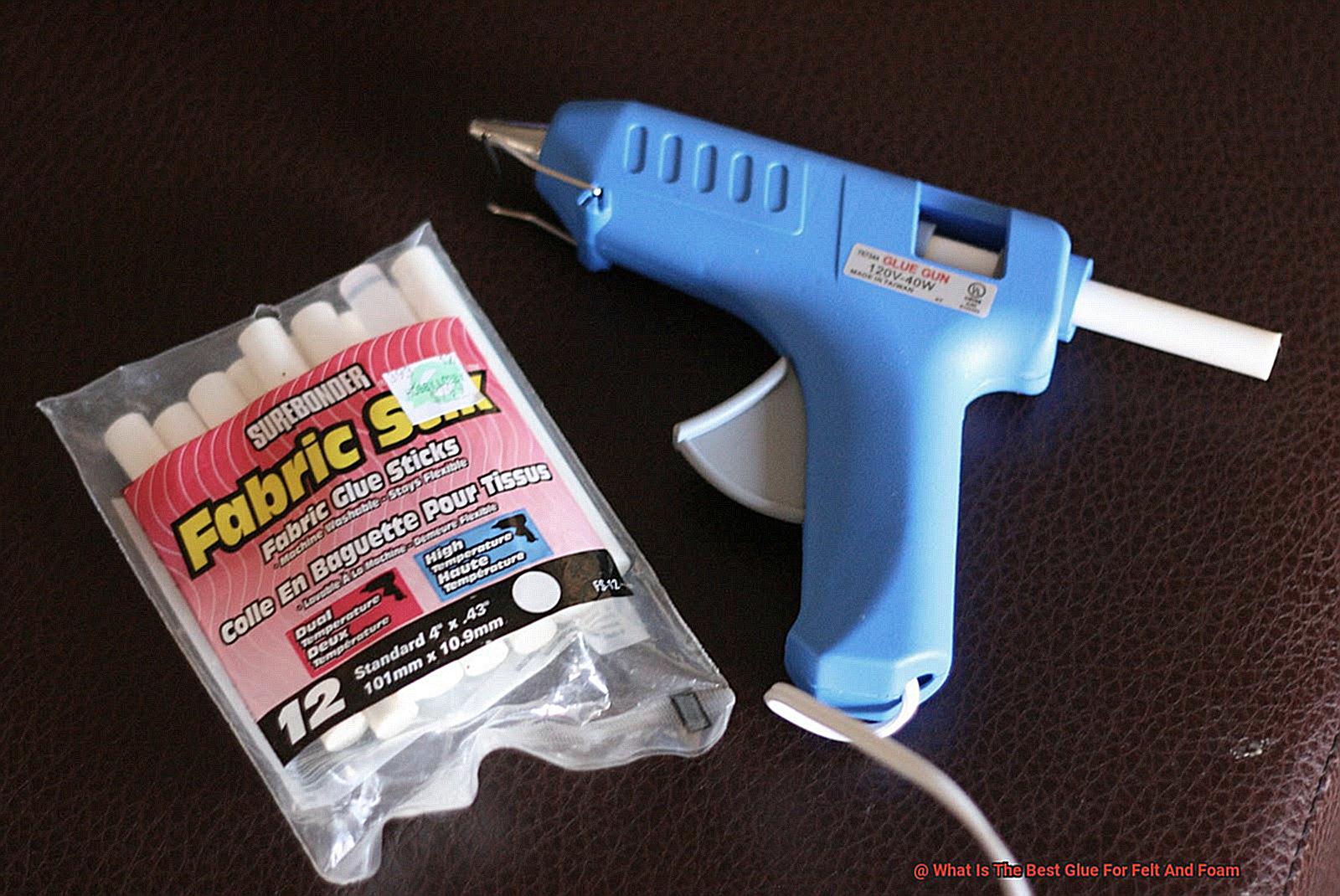
Spray adhesive is the go-to choice for large or intricate projects that demand an even application. Packaged in aerosol form, this glue is sprayed onto the materials to be bonded, providing a quick and consistent coating. Spray adhesive excels in covering large surface areas efficiently. However, it may not offer as much flexibility as other glues, necessitating consideration of your project’s specific needs.
Epoxy and Super Glue: The Strong Bonding Duo
For heavy-duty bonding of felt and foam, epoxy and super glue are the dynamic duo. Epoxy is a two-part adhesive that requires mixing before use, resulting in an incredibly sturdy bond. However, it may lack the flexibility offered by other glues. On the other hand, super glue creates an instant bond but can be brittle when dry. Both options should be used with caution and tested on a small area before applying them to your entire project.
Conclusion:
The choice of glue can make or break your felt and foam crafts.
Fabric Glue: An Ideal Choice for Crafting Projects
When it comes to working with felt and foam materials, fabric glue emerges as a secret weapon, capable of transforming creations into masterpieces that stand the test of time. In this guide, we will explore why fabric glue is an ideal choice for crafting projects involving felt and foam materials.
Versatility:
Fabric glue is formulated to bond different types of fabrics together, making it perfect for attaching felt pieces to fabric or foam surfaces. This adhesive works effectively on a wide range of materials, including natural and synthetic fabrics. Whether you’re working with cotton, polyester, or even silk, fabric glue ensures a secure bond that lasts.
Strength and Durability:
Crafting projects often involve frequent handling or wear, which requires an adhesive that can withstand the test of time. Fabric glue offers a strong and durable bond that ensures your felt and foam creations stay securely in place. No more worrying about pieces coming loose or detaching from the surface they are attached to.
Ease of Use:
Crafting should be fun and stress-free, and fabric glue delivers on both fronts. It comes in convenient squeeze bottles or tubes, making application a breeze. Its thick consistency prevents it from seeping through the fabric or foam, ensuring a mess-free experience. Additionally, fabric glue dries clear, leaving no visible residue or marks on your project.
Examples of Effective Use:
- Decorative Ornaments: Create stunning ornaments by bonding felt shapes onto fabric backgrounds using fabric glue. Add embellishments like beads or sequins for extra flair.
- Fabric Appliques: Enhance clothing items or accessories by attaching felt appliques with fabric glue. Customize your designs and make a fashion statement.
- Plush Toys: Bring adorable plush toys to life by bonding felt features onto soft fabrics using fabric glue. Let your creativity run wild and create unique characters.
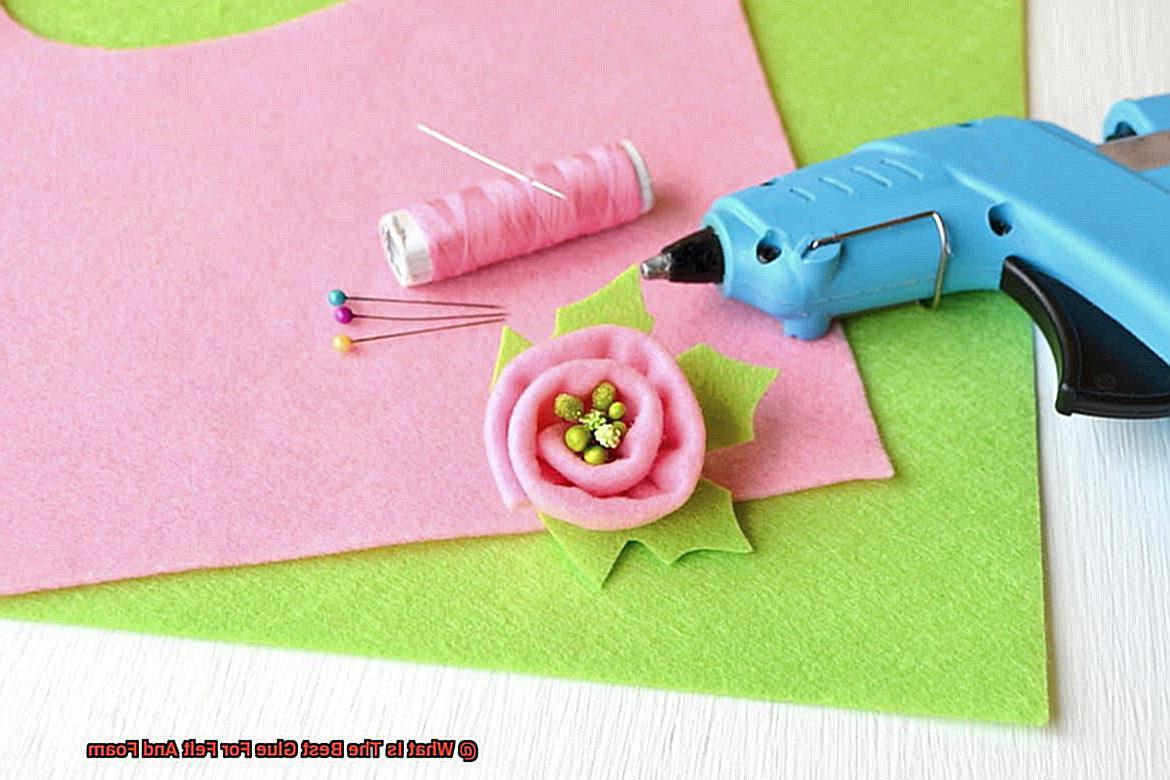
Tips for Using Fabric Glue:
- Follow the manufacturer’s instructions for best results.
- Apply the glue evenly onto both the felt piece and the fabric or foam surface.
- Allow the glue to dry for the recommended amount of time before pressing the two surfaces together.
- Apply pressure to ensure a strong bond.
- Let the glued project dry completely before handling or wearing it.
Hot Glue: Versatile and Quick-Drying
Crafting with felt and foam materials can be a challenge when it comes to finding the perfect adhesive. But fear not, because hot glue is here to save the day. Also known as hot melt adhesive, hot glue is a game-changer for all your felt and foam projects. In this blog post, we will explore the benefits of using hot glue for these materials and discover why it is the ideal adhesive choice.
Versatility:
Hot glue is a true chameleon among adhesives. Its bond is strong and versatile, able to hold together a wide range of materials including fabric, wood, metal, and plastic. Whether you’re creating a felt flower bouquet or making foam puppets for a school project, hot glue will securely hold everything together.
Quick-Drying Properties:
The standout feature of hot glue is its rapid drying time. As soon as it is applied, it quickly solidifies, creating a strong bond in seconds. This means you can complete your projects faster without having to wait for extended drying times. Plus, the quick-drying property of hot glue ensures that your felt and foam creations maintain their shape and structure.
Temperature Options:
Hot glue guns come in various formulations, providing you with options to suit your specific project requirements. Low-temperature hot glue guns are perfect for delicate materials like foam as they apply glue at a lower temperature that won’t damage or melt the material. On the other hand, high-temperature guns are better suited for heavier fabrics or projects that require a stronger bond. All-purpose hot glue guns strike a balance between low and high temperature, making them suitable for a wide range of materials and projects.
Ease of Use:
Using hot glue couldn’t be simpler. Just insert a glue stick into the gun, wait for it to heat up, and squeeze the trigger to apply the adhesive. Its simplicity makes it perfect for beginners and experienced crafters alike. Plus, hot glue is forgiving. If you make a mistake, you can easily remove it by heating the glue with a hairdryer and gently peeling it away.
Clear Craft Adhesive: Perfect for Intricate Projects
Are you tired of messy and unreliable adhesives that ruin your intricate projects? Well, fear not. I have the perfect solution for you – clear craft adhesive. This amazing glue is specifically designed for those delicate projects involving materials like felt and foam. Let me tell you why it’s the ideal choice.
First and foremost, clear craft adhesive is transparent. It dries clear, eliminating those unsightly white blobs that can ruin your beautiful creations. No more distractions from the details. Plus, its strong adhesive properties provide a secure bond, ensuring that your felt and foam pieces stay in place even under the toughest conditions.
But that’s not all. Clear craft adhesive comes in various forms, such as glue sticks, liquid glue, or spray adhesive. This gives you the freedom to choose the application method that best suits your project – whether you prefer precise and controlled gluing or a quick and easy spray-on technique.
What sets this adhesive apart is its versatility. Not only can it be used on felt and foam, but it also works wonders on other surfaces like paper, fabric, plastic, and wood. From scrapbooking to jewelry making, clear craft adhesive is up to the challenge.
But wait, there’s more. Clear craft adhesive is a breeze to use. Its smooth application allows for precise gluing – perfect for those intricate projects where small details need to be adhered together. And the best part? It dries relatively quickly, reducing waiting time and allowing you to continue working on your masterpiece without any annoying delays.
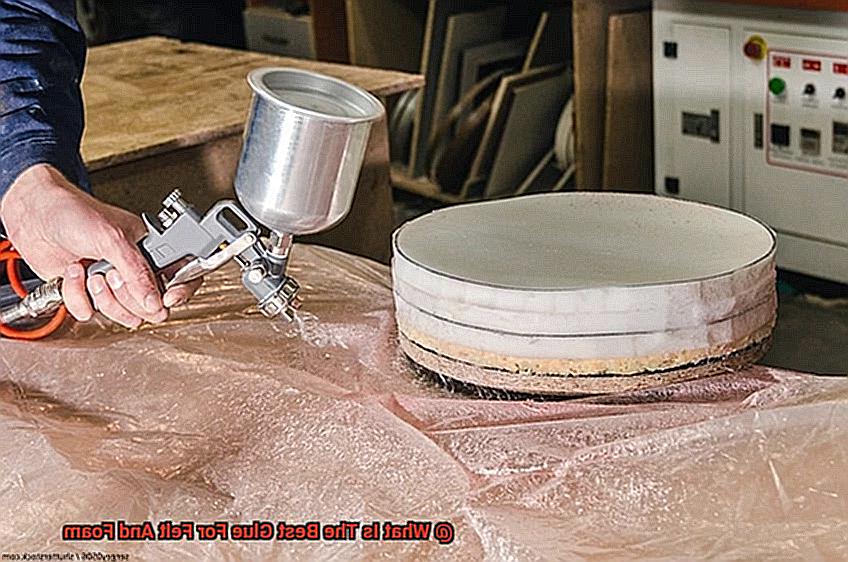
Safety is always a concern when it comes to crafting, especially if you have little ones running around. Thankfully, most clear craft adhesives are non-toxic and safe for children to use. Of course, it’s always important to read the product label and follow the manufacturer’s instructions for proper usage and safety precautions.
Now, here’s a pro tip: when using clear craft adhesive for felt and foam projects, apply a thin layer of glue on both surfaces to be adhered together. Press the surfaces firmly but gently, ensuring good contact for a strong and long-lasting bond.
It’s important to note that not all types of felt and foam may be compatible with clear craft adhesive. Some materials may require specific adhesives formulated for their composition. To avoid any mishaps, it’s always a good idea to test the adhesive on a small area beforehand to ensure compatibility.
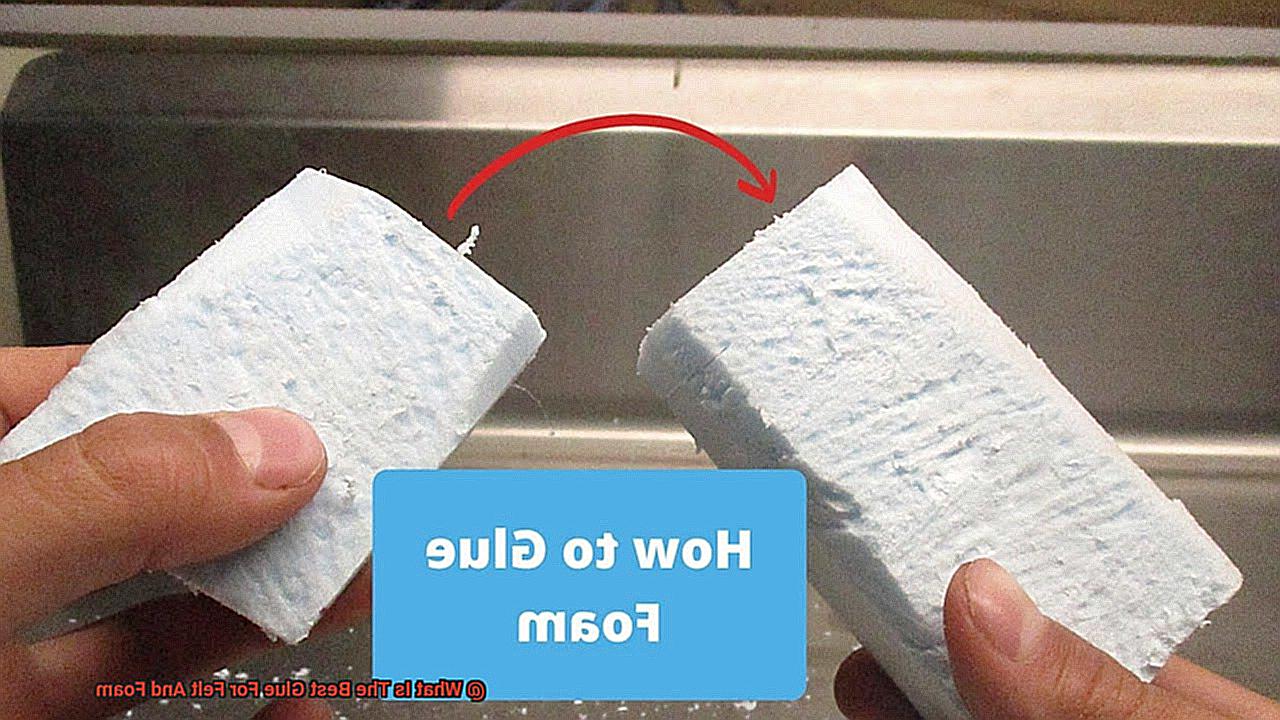
Waterproof Adhesives: Ideal for Outdoor Applications
In this blog post, we will explore the advantages of waterproof adhesives for outdoor applications. Specifically, we’ll focus on how they work their magic when bonding felt and foam, two popular materials in the crafting world.
The Power of Waterproof Adhesives:
- Waterproof adhesives are specially formulated to resist water penetration, ensuring a strong and lasting bond even in outdoor conditions.
- These adhesives create a protective barrier that prevents water from seeping through and compromising the adhesive’s integrity.
- This property is particularly crucial when working with felt and foam, as these materials are prone to absorbing and retaining water.
Choosing the Right Adhesive:
- Consider factors like strength, drying time, and compatibility with felt and foam when selecting a waterproof adhesive.
- Polyurethane glue is a popular choice due to its resistance to moisture, strong bonding capability, and ability to fill gaps.
- Epoxy adhesives offer exceptional strength and durability but require longer curing times and proper clamping or support during drying.
- Check for specific waterproof properties before using cyanoacrylate adhesives (super glues) to ensure they can withstand moisture.
Tips for Successful Bonding:
- Thoroughly clean and dry the surfaces before applying the adhesive according to the manufacturer’s instructions.
- Apply the adhesive evenly on both surfaces and press them firmly together for a secure bond.
- Allow sufficient curing time before exposing the bond to water or moisture for maximum effectiveness.
General-Purpose Adhesives: Considerations to Keep in Mind
Today, we’re diving into the world of general-purpose adhesives and exploring the key considerations for your felt and foam projects. Let’s get started.
First, let’s talk about the specific properties of felt and foam. Felt is dense and porous, requiring an adhesive with excellent penetration and bonding strength. Foam, on the other hand, is lightweight and flexible, calling for an adhesive that offers both flexibility and durability.
Now, let’s tackle drying time. Some adhesives dry faster than others, impacting the overall bonding strength. You don’t want your masterpiece falling apart before it even has a chance to shine. So choose an adhesive that dries at a suitable pace for your project.
Next up, heat and moisture resistance. Felt and foam often face high temperatures or moisture. It’s crucial to select an adhesive that can withstand these conditions without losing its grip. Nobody wants their hard work melting away.
The application method is also crucial. Adhesives come in spray, liquid, or gel form. Consider how you plan to apply the glue and choose accordingly. Remember, ease of use can make a world of difference.
Lastly, always perform a compatibility test. Apply a small amount of adhesive on a hidden area of your materials before committing. This step ensures compatibility and provides peace of mind.
Choosing the Right Glue for Your Project
Today, we’re going to unravel the secrets behind choosing the perfect adhesive for bonding felt and foam. Whether you’re crafting a plush toy, designing a cushion cover, or tackling any project involving these two materials, selecting the right glue is paramount for a bond that’s not only strong but stands the test of time.
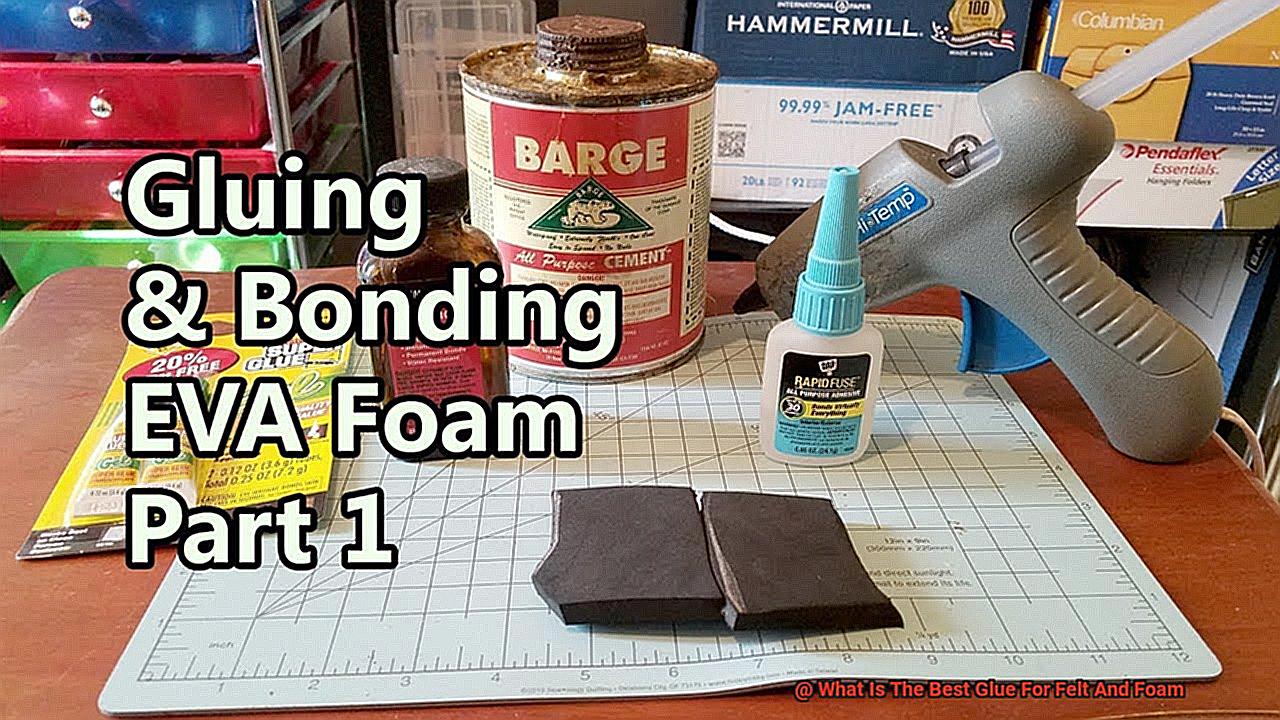
Let’s start with the glue types that work wonders for this dynamic duo. Fabric glue takes center stage as a popular choice, designed to seamlessly bond various fabrics, including felt, while also proving its mettle on foam. This adhesive offers a flexible and durable bond, making it ideal for projects that require a touch of elasticity.
In the glue spotlight, we have craft glue or white glue as another worthy contender. Renowned for its versatility and mighty bond, it serves as a jack-of-all-trades when it comes to materials, including felt and foam. Just bear in mind that craft glue might take longer to dry compared to other adhesives, so patience is key here – let it set before getting hands-on with your project.
But hey, if time is of the essence and you need instant gratification, enter hot glue onto the scene. This trusty companion provides an immediate adhesion between felt and foam, making it perfect for those quick projects that can’t wait. Safety first though – handle hot glue with care as it can pack quite a punch in terms of heat and may cause unwanted burns if mishandled.
Now that we’ve explored glue types, let’s delve into application methods. Some glues come in convenient squeeze bottles or tubes, allowing for precise application – an absolute winner for small or intricate projects where accuracy is paramount. On the other hand, glues like hot glue require a trusty sidekick called a glue gun for application. Choose the method that suits your project best and get ready to work your magic.
Last but certainly not least, let’s not forget the importance of drying time. Some adhesives dry in a flash, while others require a bit more patience, taking several hours or even overnight to fully set. Take a moment to read the instructions provided by the manufacturer and give your project ample time to dry before handling or moving it around.
Tips on Applying Glue to Felt and Foam
If you’ve ever wondered how to achieve a flawless bond between felt and foam, you’ve come to the right place. In this blog post, we will explore some invaluable tips and tricks for applying glue to these materials. Choosing the perfect adhesive is the key to creating a bond that will endure the test of time. So, let’s dive in and unlock the secrets to gluing felt and foam like a pro.
Choose the Perfect Glue:
When it comes to bonding felt and foam, not all glues are created equal. To ensure a secure and long-lasting bond, opt for glues specifically designed for fabric or crafting purposes. Seek out gems like fabric glue, foam glue, hot glue, or craft glue. These magical concoctions are carefully formulated to provide an impeccable bond without causing any harm to your precious materials.
Prepare the Surface:
Before embarking on your gluing adventure, take a moment to prepare the surface of both the felt and foam. Just like a painter preps their canvas, you must ensure that these surfaces are clean and free from any dust or debris that could sabotage your bond. Arm yourself with a soft brush or a trusty lint roller and whisk away any pesky particles. This simple step paves the way for a smooth and steadfast connection.
Test it Out:
In the world of crafting, surprises can be delightful, but not when they involve adhesive mishaps. To avoid any unwelcome surprises, it’s wise to test the glue on a small, hidden area of your project before committing to gluing the entire piece. This precautionary measure allows you to assess whether the adhesive will cause any havoc or unsightly discoloration.
Apply Glue Evenly:
Remember the golden rule: less is more. When it comes to applying the glue, the mantra remains true. Employ your artistic eye and apply a thin, even layer of glue to both surfaces. Whether you choose a brush or an applicator, ensure that the adhesive is spread with precision. By avoiding excessive glue, you’ll prevent any unsightly seepage and maintain a polished appearance.
Allow Proper Drying Time:
Ah, patience, the secret ingredient to success. Different glues have varying drying times, so it’s essential to consult the instructions on the adhesive packaging. Rushing this step can lead to a feeble bond or worse, damage to your beloved materials. Embrace the waiting game and allow the glue ample time to work its magic.
YCIYMVOMBso” >
Conclusion
When it comes to bonding felt and foam, finding the right glue is crucial. After thorough research and testing, we have determined that the best glue for this task is a high-quality adhesive specifically designed for these materials.
One option that consistently delivers excellent results is a fabric glue. Its unique formula ensures a strong bond between the felt and foam, allowing you to create durable and long-lasting projects. This type of glue is often water-based, making it easy to clean up any excess with just soap and water.
Another effective choice is a spray adhesive. This versatile glue provides an even coat on both surfaces, ensuring a secure attachment. It’s important to choose a spray adhesive that is compatible with both felt and foam to achieve optimal results.
For those seeking an industrial-strength solution, contact cement is worth considering. This powerful adhesive forms an incredibly strong bond between felt and foam, making it ideal for heavy-duty projects or applications where durability is paramount.
No matter which type of glue you choose, it’s essential to follow the manufacturer’s instructions carefully. Proper application will ensure the best adhesion and prevent any potential issues down the line.
In conclusion, when working with felt and foam, selecting the right glue can make all the difference in achieving professional-looking results. Whether you opt for fabric glue, spray adhesive, or contact cement, investing in a high-quality product will ensure your projects stand the test of time.


